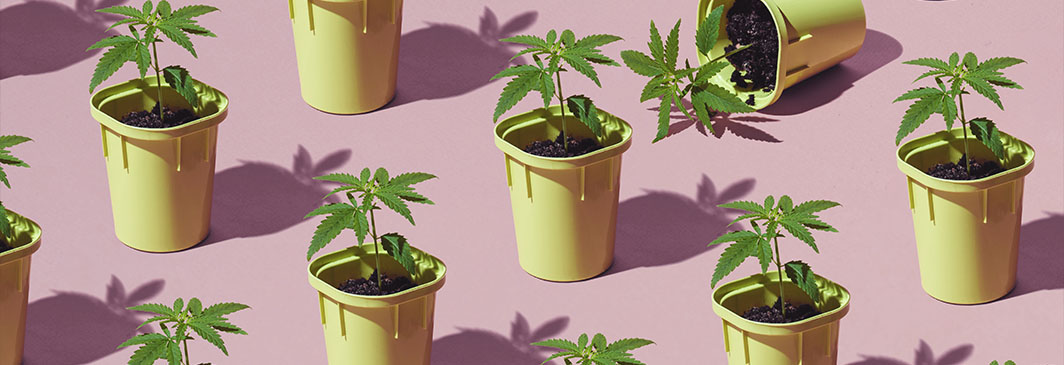The end product might be in the form of a topical, edible or tincture, but all MJ starts out as a plant. And as anyone who has ever tended a backyard garden knows, plants need care and nurturing to make it from tiny seed to full grown flower. Even if you’re not planning to become a grower, it’s good to know how your stash gets from dirt to dispensary.
In this post, we’ll explore the cannabis cultivation process from start to finish, including how to choose the right type of plant, where to grow and the stages of cannabis development.
What Makes up a Cannabis Plant?
Each cannabis plant is made up of six sections: Bud, stem, branches, nodes, leaves and cola. Cannabis plants are also divided into male and female. Male cannabis plants do not have buds but are essential in the breeding process. Female cannabis plants, those that contain buds and produce seeds when pollinated, are highly sought after.
According to the Cannabis Grow Bible by Greg Green, “A non-pollinated female plant will produce more flowering buds with no seeds and will produce higher quantities of THC than the male plant or a seeded female plant. … It should be the goal of every Cannabis user to grow non-pollinated female plants with big buds. The goal of a cannabis breeder is to produce quality seeds and plants.”
Choosing the Right Cannabis Type
For home growers, the type of plant you choose is going to depend on what you like. Historically, cannabis was divided into three main categories: sativa, indica and hybrid.
More and more, the industry is getting away from that terminology and instead highlighting cannabis properties , which are especially useful for knowing what to grow.
- Type I indicates high levels of THC.
- Type II contains a balanced combination of THC and CBD
- Type II is high in CBD
Of course, a lot more goes into the quality and type of high you get from a specific strain — there’s also THCA, CBG and Terpenes, to name a few. The best way to understand the effects of each strain is to stop in and talk with a knowledgeable budtender.
Preparing Your Space
Cannabis can be grown outdoors or indoors. Hobbyists will need dedicated space to cultivate and care for cannabis plants. The minimum requirement is generally about 10 square feet, but the space will largely depend on the number of plants and how you grow them.
Indoor growers have the ability to control the environment so cold weather isn’t as much of an issue. But you will need a dedicated light source. Outdoor growers have the sun on their side, but in Oregon and other locations where the climate fluctuates, timing is important.
Where to Buy Seeds & Clones
If you choose to start with seeds, some dispensaries sell them, but it’s often easier to order them online from a reputable seed seller. Types of seeds include:
- Feminized. Bred to produce female plants.
- Autoflowering. Plants that are smaller but flower in a shorter time period.
- Regular. Naturally bred and unaltered by chemicals.
To skip the seedling step altogether, start with weed clones. A cannabis clone is a cutting from a living marijuana plant called the mother. It’s an exact replica of the mother plant that you can purchase in season (typically April–July) at your local marijuana dispensary.
The Life Cycle of Cannabis
Weed plants go through four growth stages that can last from 13 to 30 weeks depending on the conditions and strain of the plant.
1. Germination (3-10 days). Germination is the process of seed to sprout. You may have also heard this called popping. Like the word sounds, it’s when your hard, dry brown seed opens up and out pops a little white shoot (the taproot). An easy way to start the germination process is to use the wet paper towel method.
Once you see the taproot, it’s time to translate your seed into a growing medium (soil). Prepare the soil so it is moist but not soaking. Using tweezers, carefully transplant your seed into the prepared soil with the taproot facing down. Cover lightly with soil. Young seeds are delicate. Water using a spray bottle to avoid drowning the seeds.

2. Seedling (2-3 weeks). Cannabis plants in the seedling stage require moist (not soaking) conditions, warmer temps and light to help them start growing. During this stage, you’ll see your plant grow taller, but also notice a change in the type of leaves.
Seedlings begin by producing two rounded leaves called cotyledons. As the weeks progress, the leaves will start to look more like the serrated, fingered weed leaves you know and love.
Seedlings are still extremely delicate. Some common problems in this stage include:
- Overwatering. You can tell if your seedling is too damp if the soil is wet and the plant is droopy. A plant getting too much water means it’s not getting enough oxygen. This can be caused by the wrong size pot for the seed, or just watering too much.
- Underwatering. On the opposite end of the scale, when a weed seedling doesn’t have enough water as indicated by dry soil and wilted leaves, it won’t thrive. Learn good watering practices to master this delicate balance.
- Nutrient imbalance. Just like with water, cannabis plants require the correct amount and balance of nutrients like nitrogen to thrive. If you notice burnt or dried tips on weed leaves or yellowish hue you likely have a nutrient problem. Healthy weed seedlings are green.
- Not enough light. If you notice your seedlings are “leggy,” or have a particularly long stem, chances are you aren’t providing enough light and your seedling is growing tall to try to soak in as much as possible.
3. Vegetative (3-16 weeks). This period is your plant’s teenage years. During these weeks, your cannabis plant grows all the components it will need to make it a fully functioning, mature adult plant. Just like human teens, cannabis in this stage needs more space (a larger grow container), plenty of food (nutrients) and water, and some parental — um, grower — guidance known as training, which will result in larger yields.
4. Flowering (8-11 weeks). Welcome to the bud stage. This is when your female weed plant begins to produce buds. When plants enter this stage, it’s time to stop pruning. You don’t want to disrupt their bud growth. It is a good idea to trellis or scrog flowering plants to support the buds as they grow.

Harvesting and Processing the Buds
It’s payoff time! There is some debate in the grower community about how and when to harvest, primarily around wet trimming (cutting the leaves off right after harvesting the bud) vs. dry trimming (cutting the whole plant and letting it dry before you begin trimming the leaves).
There are benefits and drawbacks to both methods, and a lot will depend on personal preference.
Commercial Cultivation
Backyard or basement growing is a great way to start as a hobbyist. But, if you’re interested in creating a cultivation business there are a number of things to consider, including:
- Space. Do you have enough space to produce enough yield to make cannabis cultivation more than a hobby?
- Time. As we’ve demonstrated, cannabis cultivation is more complicated than sewing a few seeds and waiting for the buds. It’s a time-intensive process that increases the more you grow.
- Regulations. Oregonian adults are allowed to grow up to four plants per residence, but the laws and compliance considerations are different for commercial and wholesale cultivators.
Final Thoughts
Cultivating cannabis can be an intense process, but it can also be extremely rewarding. Cannabis is a natural plant with medicinal benefits. It has been used for thousands of years due to its ability to relieve pain, reduce anxiety and promote relaxation.
Before you start cultivating, it’s important to understand the cannabis plant, different strains (or cultivars), the stages cannabis goes through from seed to bud and how to properly harvest the fruits of your labor.
Still have questions? Ask! The friendly budtenders at your local marijuana dispensary know their weed, and that includes a deep understanding of how it gets from the ground to your hand.

